- Animal Testing
- Beef
- Chicken
- Circuses
- Dairy
- Dissection
- Donkeys
- Down
- Eggs
- Foie Gras
- Fur
- Honey
- Hunting
- Lobster
- Pork
- Seal Hunt
- Turkey
- Wool
- Zoos
Pork

Most pigs spend their lives on factory farms where their lives are pure hell.
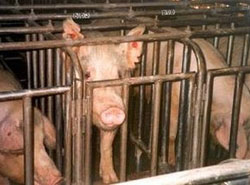
Gestation Crates
On hog factories, Mother pigs (sows) are reduced to nothing more than breeding machines. After being impregnated they are confined in gestation crates. These crates are only 7 feet long and 2 feet wide - too small to even turn around. Their pregnancies last 4 months, after which they are transferred to farrowing crates to give birth.
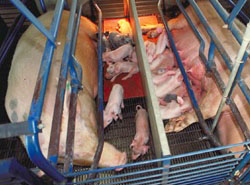
Farrowing Crates
Farrowing crates are just wide enough for the pigs to lie down and nurse their babies. Because those crates are very hard and contain no bedding at all, most sows suffer from sores on their knees and shoulders.
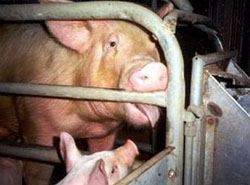
Continuous Cycle for Mothers
The piglets are removed when they are about 10 days old. Their mother is immediately impregnated again. She will give birth to more than 20 piglets each year until she is about 3-4 years old and brought to the slaughterhouse.
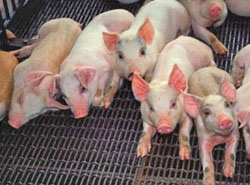
Piglets Undergo Painful Procedures
After they are removed from their mothers, the piglets are packed into overcrowded pens with concrete floors and metal bars. This causes stress-related behaviors like tail-biting. For this reason farmers will chop off their tails and break off the ends of their teeth with pliers. For identification purposes farmers will rip off pieces of their ears. No anesthetics are used for any of these procedures.
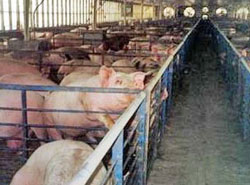
Overcrowded Pens
The pigs will stay in overcrowded pens until they have reached a weight of 250 pounds at about 6 months. They are then called hogs and are ready for the slaughterhouse.
Because of the buildup of the pigs' urine and feces in these pens, they have to breathe awful noxious gases every day of their short lives. This causes severe respiratory problems. The majority of pigs arrive at the slaughterhouse with pneumonia.
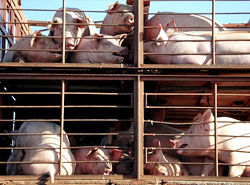
Transportation
Pigs also suffer greatly during transportation. When they resist going into the trailers, workers will use electric prods to move them along. Within the trailers they are packed so tight together that many of them die as a result.
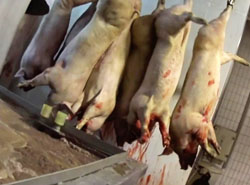
Slaughterhouse
In the slaughterhouse the pigs are hung upside down by their back legs and bleed to death. Because of improper stunning, many pigs are still alive at this point. They will kick and struggle while the slaughterhouse worker sticks a knife in their neck. After this, the pigs are thrown in a scalding tank to soften their skin and remove their hair. Some are thrown in while still alive and fully conscious.

